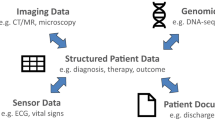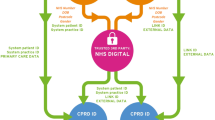Abstract
In Japan, the National Clinical Database (NCD) was founded in April 2010 as the parent body of the database system linked to the board certification system. Registration began in 2011, and to date, more than 3,300 facilities have enrolled and more than one million cases are expected to enroll each year. Given the broad impact of this database initiative, considering the social implications of their activities is important. In this study, we identified and addressed issues arising from data collection and analysis, with a primary focus on providing high-quality healthcare to patients and the general public. Improvements resulting from NCD initiatives have been implemented in clinical settings throughout Japan. Clinical research using such database as well as evidence-based policy recommendations can impact businesses, the government and insurance companies. The NCD project is realistic in terms of effort and cost, and its activities are conducted lawfully and ethically with due consideration of its effects on society. Continuous evaluation on the whole system is essential. Such evaluation provides the validity of the framework of healthcare standards as well as ensures the reliability of collected data to guarantee the scientific quality in clinical databases.
Similar content being viewed by others
References
Donabedian A. The quality of care: how can it be assessed? JAMA. 1988;260:1743–8.
Glickman SW, Baggett KA, Krubert CG, Peterson ED, Schulman KA. Promoting quality: the health-care organization from a management perspective. Int J Qual Health Care. 2007;19:341–8.
Ikegami N, Yoo BK, Hashimoto H, Matsumoto M, Ogata H, et al. Japanese universal health coverage: evolution, achievements, and challenges. Lancet. 2011;378(9796):1106–15.
Iwanaka T, Miyata H, Okubo S. Significance of National Clinical Database. Japn J Clin Med: Nippon-Rinsho. 2011;69(Sup 3):625–30 (in Japanese).
Iwanaka T, Miyata H, Okubo S, Tomotaki A. Principles of National Clinical Database. Clin Surg: Rinsho-Geka. 2012;67:742–5 (in Japanese).
Okubo S, Miyata H, Hashimoto H, Gotoh M, Murakami A, et al. National Clinical Database, Japan (NCD): department registration and data entry. Clin Surg: Rinsho-Geka. 2012;67:746–51 (in Japanese).
Mori R, Takemi K, Fineberg HV. Science and consensus for health policy making in Japan. Lancet. 2012;379(9810):12–3.
Joint Committee on Educational Evaluation; Sanders JR (chair). The program evaluation standards: how to assess evaluations of educational programs, 2nd edn. Thousand Oaks: Sage Publications; 1994.
Institute of Medicine. Crossing the Quality Chasm: a New Health System for the 21st Century. Washington, DC: National Academy Press; 2001.
Porter ME, Teisberg EO. How physicians can change the future of health care. JAMA. 2007;297:1003–111.
Japan Surgical Society. The way to become a Board Certified Surgeon: start up, planning and requirements. http://www.jssoc.or.jp/procedure/specialist/mem_doc_senmon_online2003.html. Accessed 18 April 2012 (in Japanese).
Japanese Society of Gastroenterological Surgery. New system for Board Certified Surgeon in Gastroenterology. http://www.jsgs.or.jp/modules/senmon/index.php?content_id=93. Accessed 18 April 2012.
Jamtvedt G, Young JM, Kristoffersen DT, Thomson O’Brien MA, Oxman AD. Audit and feedback: effects on professional practice and healthcare outcomes. Cochrane Database Syst Rev. 2003; 3: CD00259.
Hall BL, Hamilton BH, Richards K, Bilimoria KY, Cohen ME, et al. Does surgical quality improve in the American college of surgeons national surgical quality improvement program. An evaluation of all participating hospitals. Ann Surg. 2009;250:363–76.
Berwick DM, James BC, Coye M. The connections between quality measurement and improvement. Med Care. 2003;41(1 suppl):I30–8.
Goetzel RZ, Ozminkowski RJ, Villagra VG, Duffy J. Return on investment in disease management: a review. Health Care Financ Rev. 2005;26:1–19.
Miyata H, Motomura N, Murakami A, Takamoto S, Japan Cardiovascular Surgery Database. Effect of benchmarking projects on outcomes of coronary artery bypass graft surgery: challenges and prospects regarding the quality improvement initiative. J Thorac Cardiovasc Surg. 2012;143:1364–9.
Landon BE, Normand SL, Blumenthal D, Daley J. Physician clinical performance assessment: prospects and barriers. JAMA. 2003;290:1183–9.
Schneider EC, Spstein AM. Influence of cardiac-surgery performance reports on referral practices and access to care-a survey of cardiovascular specialists. N Engl J Med. 1996;335:251–6.
Miyata H, Motomura N, Kondo MJ, Fushimi K, Ishikawa KB, et al. Toward quality improvement of cardiovascular surgery in Japan: An estimation of regionalization effects from a nationwide survey. Health Policy. 2009;91:246–51.
Vaughan-Sarrazin MS, Hannan EL, Gormley CJ, Rosenthal GE. Mortality in medicare beneficiaries following Coronary Artery Bypass Graft surgery in states with and without certificate of need regulation. JAMA. 2002;288:1859–66.
The Ministry of Education, Culture, Sports, Science and Technology, and the Ministry of Health, Labor and Welfare. The Ethical Guidelines for Epidemiological Research. December 1, 2008. (Partial revision). http://www.niph.go.jp/wadai/ekigakurinri/H20_12_01_shishin-all.pdf. Accessed 18 April 2012 (in Japanese).
Serruys PW, Morice MC, Kappetein AP, Colombo A, Holmes DR, et al. Percutaneous coronary intervention versus coronary-artery bypass grafting for severe coronary artery disease. N Engl J Med. 2009;360(10):961–72.
The Ministry of Education, Culture, Sports, Science and Technology, and the Ministry of Health, Labor and Welfare. The Ethical Guidelines for Clinical Research; July 30, 2008. (Revision). http://www.mhlw.go.jp/general/seido/kousei/i-kenkyu/rinsyo/dl/shishin.pdf. Accessed 18 April 2012 (in Japanese).
Day M. Patients can opt out of controversial national records system. BMJ. 2007;334(7583):12.
The European Communities. Directive 95/46/EC; 1995. http://ec.europa.eu/justice/policies/privacy/law/index_en.htm. Accessed 18 April 2012.
National Institute of Health. 45 Code of Federal Regulations (CFR) Part 46; 2005. http://ohsr.od.nih.gov/guidelines/45cfr46.html. Accessed 18 April 2012.
The United States President’s Commission. Final report of the ethical and legal problems in medicine and biomedical and behavioral research. Tokyo: Shinohara Publication; 1984 (in Japanese).
Society of Thoracic Surgeons. Guidelines on Use of STS National Database and Database-derived Information. 10th October 2004. http://www.ctsnet.org/file/STSNationalDatabasesGuidelines3FINAL.pdf. Accessed 18 April 2012.
Japan Surgical Society. Disclosure of the Result and the Process of Ethical Review about National Clinical Database. 2010. http://www.jssoc.or.jp/other/info/info20101117.html. Accessed 18 April 2012 (in Japanese).
Shahian DM, O’Brien SM, Filardo G, Filardo G, Ferraris VA, Haan CK, et al. The Society of Thoracic Surgeons 2008 cardiac surgery risk models: part 1—coronary artery bypass grafting surgery. Ann Thorac Surg. 2009;88(1 Suppl):S2–22.
The Ministry of Health, Labour and Welfare. An Administrative Cross-Country Study of Medical Facilities in Japan (Iryo-shisetsu Tyousa). 2008. http://www.mhlw.go.jp/toukei/saikin/hw/iryosd/08/. Accessed 18 April 2012 (in Japanese).
Japan Surgical Society. About the Japan Surgical Society. 2012. http://www.jssoc.or.jp/aboutus/society/info.html. Accessed 18 April 2012 (in Japanese).
Acknowledgments
The authors would like to express appreciation to all of the people and academies that cooperated in this project.
Conflict of interest
None of the authors have any conflict of interest.
Author information
Authors and Affiliations
Corresponding author
Rights and permissions
About this article
Cite this article
Miyata, H., Gotoh, M., Hashimoto, H. et al. Challenges and prospects of a clinical database linked to the board certification system. Surg Today 44, 1991–1999 (2014). https://doi.org/10.1007/s00595-013-0802-3
Received:
Accepted:
Published:
Issue Date:
DOI: https://doi.org/10.1007/s00595-013-0802-3




